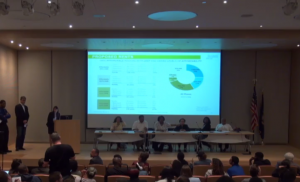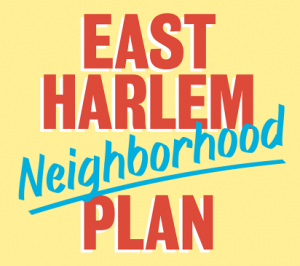
The ANHD Blog raises the profile of our issues, and educates our member groups, city decision makers, and the general public on our core issue areas. The ANHD Blog offers sharp, timely and effective commentary on key public policy issues, as well as our work and the work of our member groups.
All of our blogs are sorted based on the issues, projects, special tags, and dates they are associated with, and you can use the dropdowns below to filter through our blogs based on these tags. Additionally, you can do a general search through our blog, using the search bar the right. If you can’t find what you are looking for, email comms@anhd.org.
East Harlem Residents Push Back on City Rezoning Plan at Packed Community Board Hearing
A crowd overflowed the Silberman School of Social Work at Hunter College last night for the Community Board 11 Land Use Committee's public hearing on the proposed East Harlem neighborhood rezoning. This is the first public testimony of the seven-month public review process, the first chance for the community to respond publicly to the City's plans and, most importantly, a chance for the City to show whether it is in fact adopting a community-based planning approach to rezonings.
A crowd overflowed the Silberman School of Social Work at Hunter College last night for the Community Board 11 Land Use Committee’s public hearing on the proposed East Harlem neighborhood rezoning. This is the first public testimony of the seven-month public review process, the first chance for the community to respond publicly to the City’s plans and, most importantly, a chance for the City to show whether it is in fact adopting a community-based planning approach to rezonings.
East Harlem marks the third neighborhood rezoning to begin the public review process under the de Blasio administration. Upon taking office, de Blasio promised a different, more comprehensive approach to neighborhood rezonings – one that meaningfully involves communities in the planning process to better ensure the priorities of local residents are met. And in East Harlem, the approach has indeed been different. In 2015, after East Harlem was identified for a potential rezoning, City Council Speaker Melissa Mark-Viverito brought together local stakeholders in the formation of a steering committee tasked with crafting a comprehensive plan identifying the neighborhood’s goals and needs. After months of community engagement, consensus-building, and dedicated work, the steering committee – led by the Speaker’s Office, Manhattan Community Board 11, Community Voices Heard, and Manhattan Borough President Gale Brewer – unveiled their vision with the East Harlem Neighborhood Plan (EHNP), including a broad set of demands across 232 recommendations.
Yet the question has always been to what degree will the EHNP influence the rezoning of East Harlem? The Department of City Planning (DCP) held off on releasing their rezoning proposal until the EHNP’s recommendations were complete and its goals for the neighborhood made clear. But it’s important to note that true community involvement in the planning process is meaningless if there is not true community involvement in the planning outcomes. If the recommendations of the East Harlem Neighborhood Plan are not meaningfully incorporated in DCP’s East Harlem rezoning plan, then what was the entire process for?

This is among the questions community residents and local organizations raised over and over again last night. In addressing their issues and concerns around DCP’s plan, speakers stressed the numerous ways it differs from the East Harlem Neighborhood Plan. These include, most pressingly, questions around the affordability of new construction, particularly on public land, and the need for strong housing preservation strategies. The EHNP includes recommendations for permanent and deeply affordable units on public sites using locally based non-profit developers and community land trusts to help achieve these goals – a key aspect of the plan’s overall call for 50% of all new housing in the neighborhood to be affordable. The plan calls for a Certificate of No Harassment program (CONH) to be put in place in East Harlem. The plan also calls for a $200 million investment in NYCHA repairs and preservation in the neighborhood as a down payment for the $1 billion local need. These are just some of the key priorities the East Harlem Neighborhood Plan puts forward that are all unfortunately absent from DCP’s current rezoning plan in any meaningful fashion. These are all key priorities that community members stressed had to be included before the City’s plans could move forward. In addition, speakers highlighted that DCP’s proposed zoning includes significantly higher densities than the EHNP recommended.
 Community members and organizations engaged in the East Harlem Neighborhood Plan in a good faith effort to find solutions for the neighborhood’s needs. They gave their time and energy to make this happen. As one Community Voices Heard member put it, “I feel like the City is ignoring two years of visioning sessions, and man, that feels like I wasted my time.” This shouldn’t be the case. ANHD believes in community-based planning as a way to provide local residents meaningful control over the future of their neighborhoods. This doesn’t mean the East Harlem Neighborhood Plan cannot be strengthened and made more reflective of what the community needs; it can and it should be. But what shouldn’t happen is the City paying lip service to the EHNP while making its recommendations weaker. East Harlem is a chance to get it right and set a new standard for neighborhood rezonings moving forward citywide. The groundwork has been laid already. Now the City must ensure it hasn’t been in vain.
Community members and organizations engaged in the East Harlem Neighborhood Plan in a good faith effort to find solutions for the neighborhood’s needs. They gave their time and energy to make this happen. As one Community Voices Heard member put it, “I feel like the City is ignoring two years of visioning sessions, and man, that feels like I wasted my time.” This shouldn’t be the case. ANHD believes in community-based planning as a way to provide local residents meaningful control over the future of their neighborhoods. This doesn’t mean the East Harlem Neighborhood Plan cannot be strengthened and made more reflective of what the community needs; it can and it should be. But what shouldn’t happen is the City paying lip service to the EHNP while making its recommendations weaker. East Harlem is a chance to get it right and set a new standard for neighborhood rezonings moving forward citywide. The groundwork has been laid already. Now the City must ensure it hasn’t been in vain.


